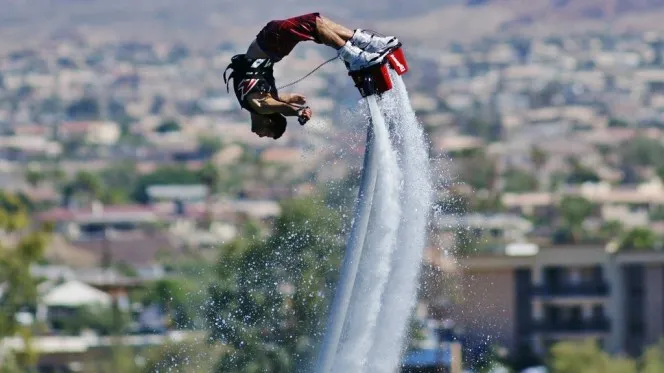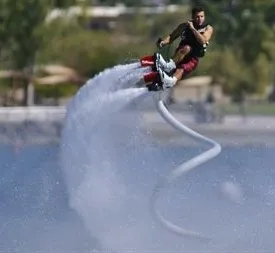
It’s not hard to stand in awe of the aerial acrobatics achieved by those athletes in command of World Champion racer Frankly Zapata’s impressive Flyboard. Part snowboard and part jet pack, the Flyboard looks deceptively easy.
Riders’ feet are strapped into fixed boots similar to a snowboard, which channels the thrust provided by a modified personal watercraft runabout (sitdown) which pushes a torrent of water through the 18 meter-long hose, allowing the rider heights up to 10 meters above the water.
Of course, nobody expects first-time riders to achieve the impressive backflips, porpoise dives and other trick moves executed by those who have dedicated hundreds of hours to learning the intricacies of the Flyboard, but that’s OK; Zapata Racing offers a pair of arm braces that likewise pump thrust through each gauntlet, letting you literally fly like Iron Man.
It’s impressive to see and even more to try and are looking at seeing more Flyboards being used for recreational use rather than just exhibition.


The Flyboard has one fatal flaw: it requires significant athleticism to master. A precarious balance of muscle and throttle control are needed to make the Flyboard soar, and there lies its greatest limitation, that is, at least in the eyes of many. For others who might be physically capable of attempting the Flyboard, the deterrent comes from a far more carnal instinct: self-preservation.
For the same reason why normally adventuresome persons are petrified of riding roller coasters, the thought of relinquishing control (and perceived safety) to the pulls of velocity, gravity and centrifugal force as well as man-made machine is all too much to handle. But more commonly, the physical needs of balance, strength and control are simply too far outside of the mainstream.
OK, here’s where we’re going to get mean: There’s not a lot of proficient standup watercraft riders who are overweight or all that clumsy (although imagining one is pretty funny). Once given the option of a traditional standup ski or a runabout, mainstream Americans gravitated towards the craft that required less physical exertion to operate so much so, that OE manufacturers eventually ceased drastically dialed back building skis altogether.
The second major strike against the Flyboard is its dependence on an existing four-stroke runabout; albeit the genius behind the design of the Flyboard. Its redirection of the pump thrust to a pair of nozzles mounted to the board provide the vertical lift necessary to levitate over the surface and – once a certain degree of confidence is achieved – rotate, spin and maneuver. Likewise, as mentioned previous, a pair of stabilizer jets mounted to left and right hand gauntlets provide additional control.


Yet, without a runabout at the ready, the Flyboard remains dead in the water, so to speak. A 30-foot hose mounts to a coupler that interrupts the factory pump housing of the watercraft to redirect the thrust to the Flyboard. The PWC remains operable but in a limited fashion as it is serves almost exclusively to propel the Flyboard.
Audiences and enthusiasts have shown interest in the Flyboard but mainly as a source of brief entertainment, not necessarily a sport of its own. The aftermarket has also shown limited interest in the Flyboard.
PWC Performance offers custom-made Skat-Trak Twin Drive impellers. The dual-sided impeller features main drive 4-blade impeller and an inducer impeller to improve thrust while scrubbing vibration and cavitation commonly found on stock-equipped PWC powering a Flyboard.
Owner, Jerry Gaddis, stated, “I think it’s a very small market, but the guys that have them seem very passionate about them.”
Whether the Flyboard is a fad or will become a permanent fixture in the personal watercraft industry remains unseen. Yet, like so much, it all depends on the public’s acceptance.
All images: Clay Tolbert








